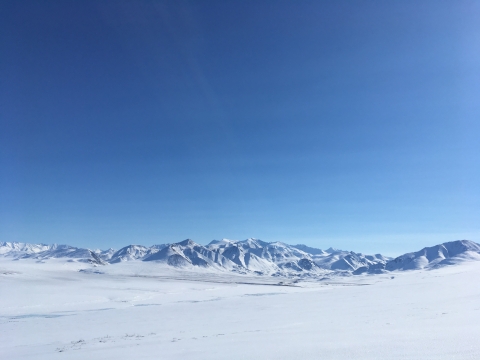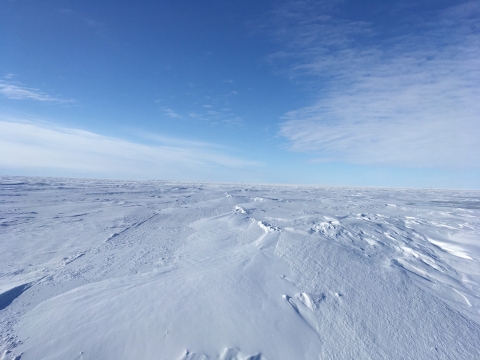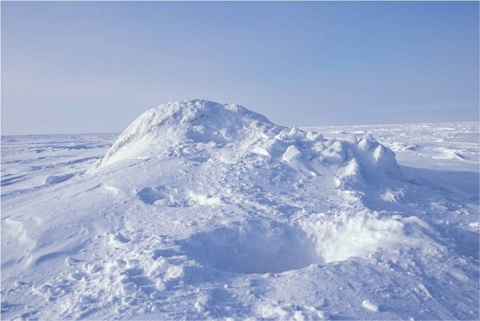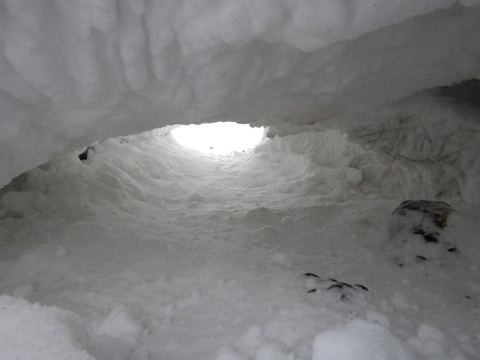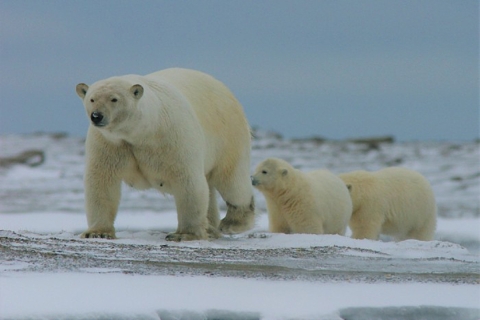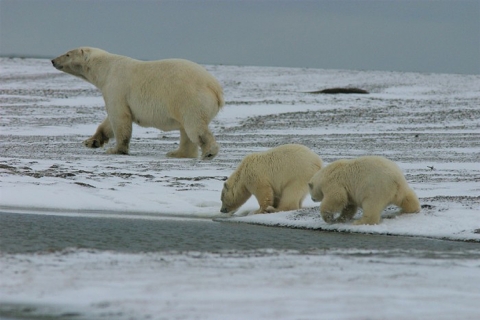The great white bears that walk the land and sea ice of northeastern Alaska and northwestern Canada make up the southern Beaufort Sea subpopulation of polar bears in the circumpolar North. Indigenous peoples have lived here for thousands of years with Nanuuq, the Inupiaq name for the polar bear; traditional knowledge holds great respect for the bear, in part for its clever adaptations to hunting and living on both sea and land and surviving in difficult conditions. The behavior and biology of the Beaufort Sea bears inspired the following story of a year in the life of a female polar bear along the coast of Arctic National Wildlife Refuge.
. . .
It is early spring in the Arctic, and the sun rests higher in the sky than it has in months. Light reflects brightly on the smooth, snow-covered landscape of the Arctic National Wildlife Refuge coastal plain. Though the sunshine provides a gentle warmth, the temperature is still below freezing.
[Daylight quickly returns to the high Arctic during the spring, reflecting off mountains and tundra.]
[Early spring Arctic sea ice covered in snow.]
On the surface of the snowdrifts, all is still. Yet hidden below the snow, a polar bear stirs. Five years ago, this bear had been a tiny cub herself in a den on this coastal plain. Now, two fuzzy cubs rest at her side. When they were born, they were barely bigger than squirrels and completely blind. After three months of drinking their mother’s rich milk, they are now the size of Welsh corgis.
Today, however, their mother hasn’t allowed them access to her milk. The cubs yip, crawling toward her belly. She turns away, lifting her long snout to sniff the air through the small air hole in the dense snow layer over her head.
. . .
For months, this mother has rested beneath the snow. Winter denning is the norm for most bears of Arctic Refuge; almost all black bears and brown bears sleep through the months when food is scarce.
Polar bears are different: only pregnant females seek out dens, while the rest remain active throughout winter. Their fur and blubber protect them from the cold, and the sea ice provides a solid platform from which they can hunt seals.
Newborn polar bear cubs, however, lack the fur and fat needed to stay warm. So, pregnant females give birth in winter dens. There they nurse their cubs until spring, when the young are sturdy enough to venture into the world.
View from the surface of a dome of snow with recently excavated snow at the entrance of a den.
[An empty polar bear den viewed from the snowy surface, with an excavated exit hole and bear tracks, made by the bears when they departed.]
This icy den, only large enough for the mother to turn around in, has kept the polar bear cubs safe and warm. Even when winter temperatures drop as low as -40°F, the den’s temperature remains close to 32°F thanks to the mother’s warmth and the insulating snow. From in here, however, the mother cannot hunt. She hasn’t eaten since the beginning of winter, and now her fat reserves are low from sustaining herself and her two cubs.
. . .
The cubs cry louder. They haven’t eaten all day. The mother stops sniffing, perhaps because her sensitive nose hasn’t picked up the scent of any potential predators. She turns toward the snow-covered entrance to the den and digs. Her black paws, lined with white fur and bigger than dinner plates, cut through the packed snow. A circle of sunlight bursts down into the den, and the cubs blink in the brightness. Above, the mother slowly scans the horizon, looking in each direction. After a moment, she crawls out, stretching her legs for the first time in months. She tumbles down the bright snowy bluffs, wiggling to clean her thick fur on the jagged shards of wind-packed snow.
[Looking up at the exit from an abandoned polar bear den.].
Next, two cubs poke their heads out of the tunnel, seeing the outside world for the very first time. They squint at the bright sun and sniff the cold air. Their mother is now a few yards away, at the bottom of a snow drift. She seems to be inviting them to join her, enticing them with the promise of milk as she shows them her belly. They start to yip loudly — they’ve never been more than inches away from their mother.
Slowly, the first cub takes a step out of the den, struggling to stay upright while the snow slides beneath its feet. The second cub follows in its footsteps. The mother watches from below. It is vital that the cubs learn to keep up with their mother, even on tough terrain.
[Two young cubs-of-the-year (born earlier that year), or COYs, follow their mother across snow. The cubs in this photo are about 9 months old.]
Finally, the ungainly cubs reach their mother, their yips quieting to purrs as they begin to nurse. Though the mother relaxes into the snow, she constantly scans the tundra and keeps her nose lifted, ever wary of dangers.
[A polar bear mother and two young cubs sniffing the air and the ground.]
Having finished nursing, the cubs begin to wrestle. The mother watches as they gracelessly stalk and pounce. The cubs turn to look at her, then scramble over, one standing to reach her neck and the other clambering onto her back. She opens her mouth and wraps her jaws around one cub, her sharp teeth barely grazing its soft fur. Playtime is the perfect way to practice the skills her cubs will need to survive — hunting, fighting, and communicating with other bears.
[Two cubs wrestle while their mother walks nearby.]
When their mother stands and walks up the slope to their den, the cubs bound through the snow right behind her. Already they move more gracefully than they did when first stepping out of the den. In a week or two, when the cubs are ready, the family will leave their den for good. The mother will need to hunt soon, and the cubs will watch and learn. But for now, they return to their cozy home for a bit more rest.

